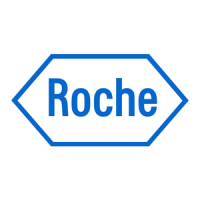Roche Diagnostics
Operator’s Manual · Version 3.1 A-19
Cedex Bio System 2 Introduction to the instrument
Overview
Principles of operation
The Cedex Bio main instrument uses absorption photometry for determining the
amount of absorbance in a fluid. The absorbance is used to calculate the
concentration in the solution.
Loading the sample The operator identifies the sample, places it on the instrument, and defines the order.
(If you work with a host system, the order is defined automatically.)
Measuring process The measuring process for each test consists of forty regular cycles, each lasting 18
seconds. In each of these cycles, a measurement is taken, irrespective of what other
actions take place during this cycle. The application definitions determine what is
done in which cycle, and they also define which results are taken into account for the
result calculation.
With each cycle, a new test can be started.
The basic process works as follows:
1. Checking the cuvette.
A measurement is taken to check the quality of the cuvette.
2. Pipetting reagent (R1) to the cuvette.
After each pipetting action, the system performs a wash cycle to minimize carry-
over. During this cycle, the probe and tubing are flushed with water and cleaner.
3. Wait.
The fluid needs to reach the prescribed temperature. Such a phase can last several
cycles.
During the wait cycles, activities for other tests are performed.
4. Pipetting the next fluid.
Typically, this would be the sample. The details are defined in the application
definitions.
5. Wait.
6. Pipetting the next fluid.
7. Wait.
8. And so on.
Calculating the results The test result is calculated on the basis of the photometric measurement results.
During this process, various checks are performed to ensure that the whole
measuring process was technically correct. If values are above or below predefined
limits, the test result is flagged.
The results are stored on the system. This includes both the forty measurement
results (raw data) and the calculated test result.
Sequence of processing For a given sample, the tests are processed in the order defined by the time required
for their processing (number of cycles), starting with the one that takes the longest.
This order can be altered manually by defining a specific process sequence list.
Status of the measuring process At any stage of the measuring process, the user can check its status on the screen.
Result data management The system provides storage space for the results of one working day. For backup
purposes, the results must be exported to an external storage device once a day.

